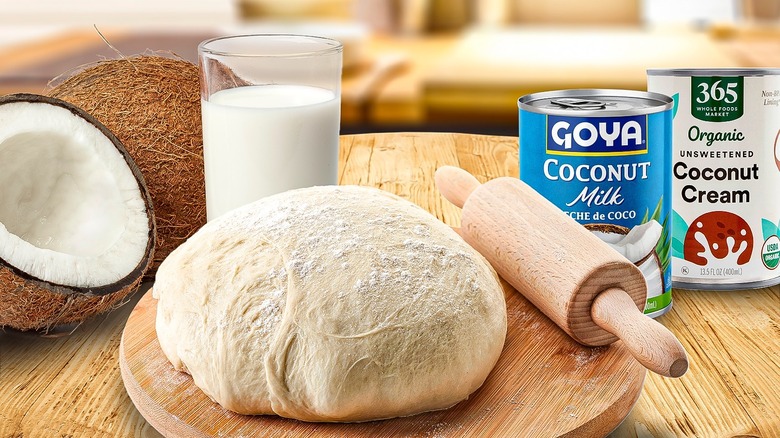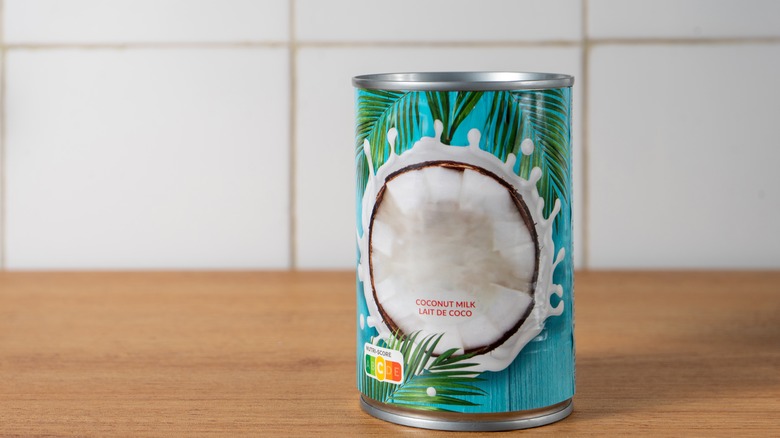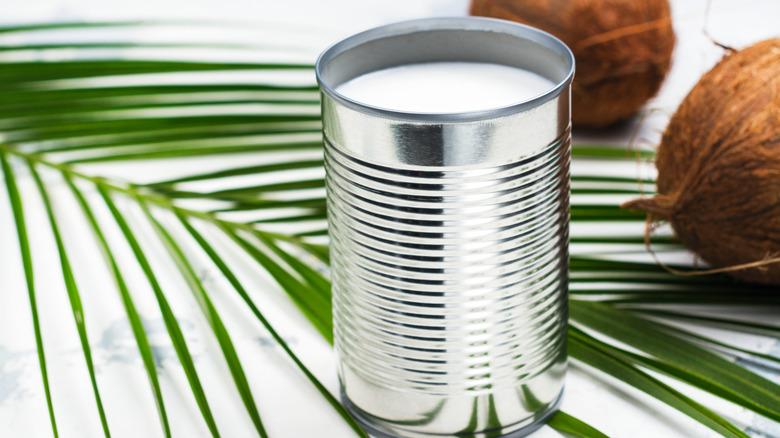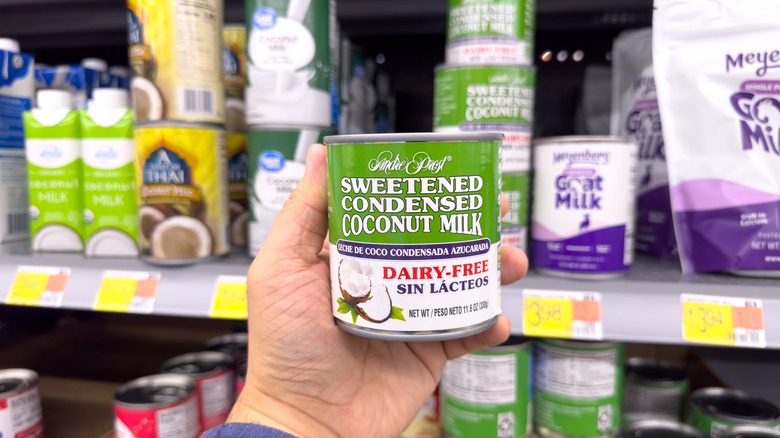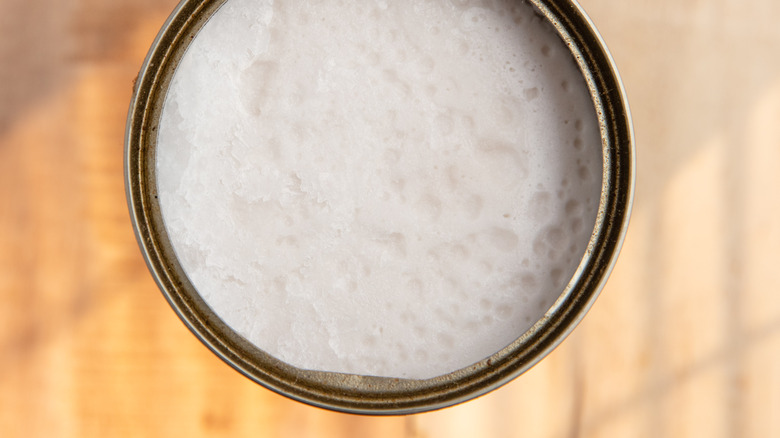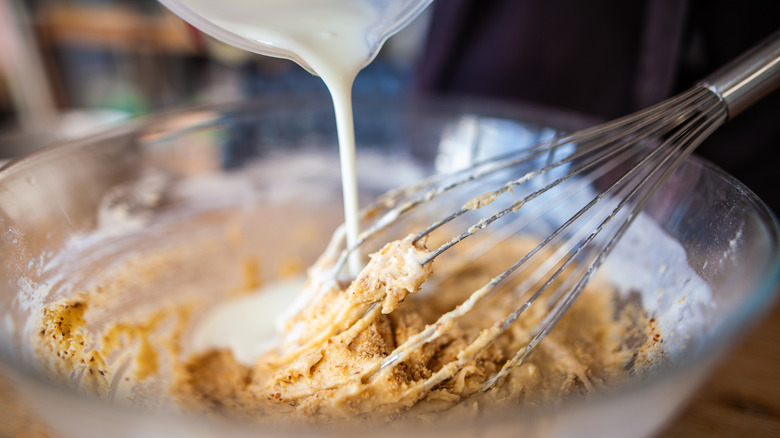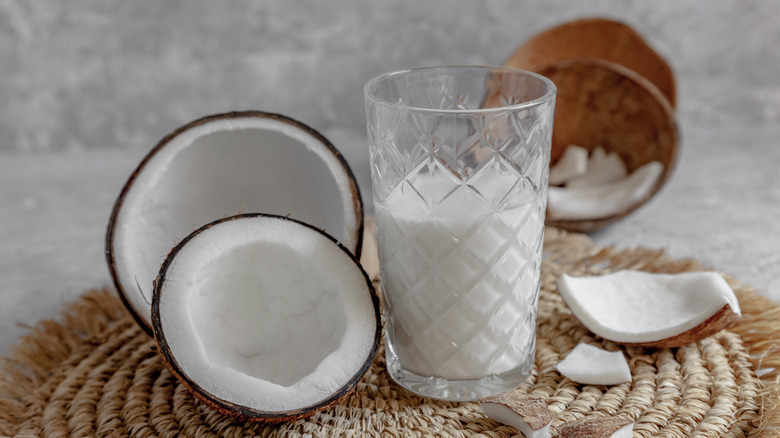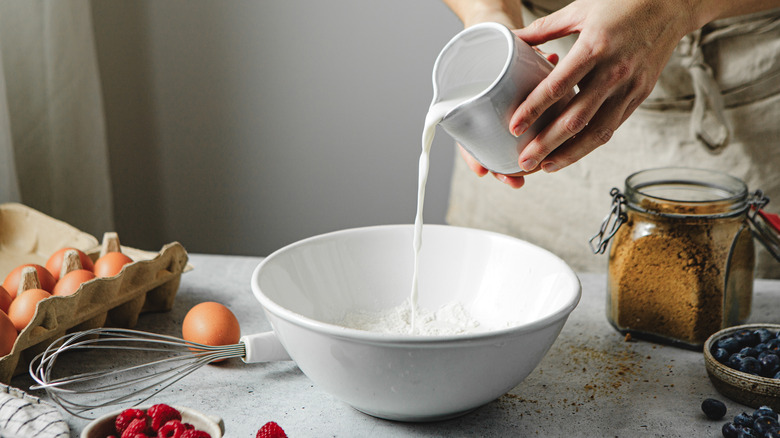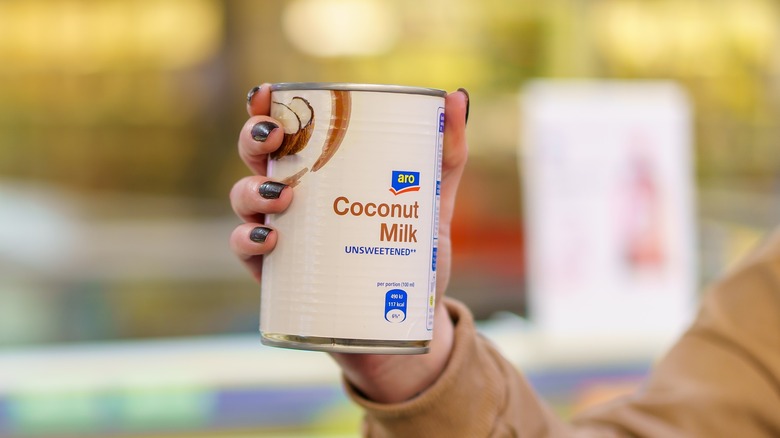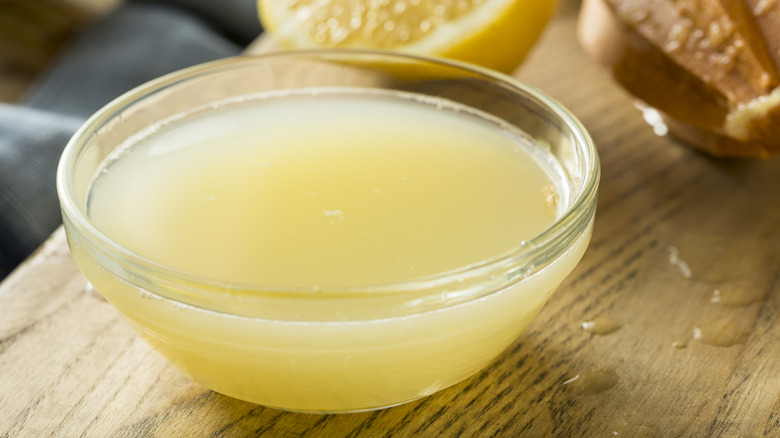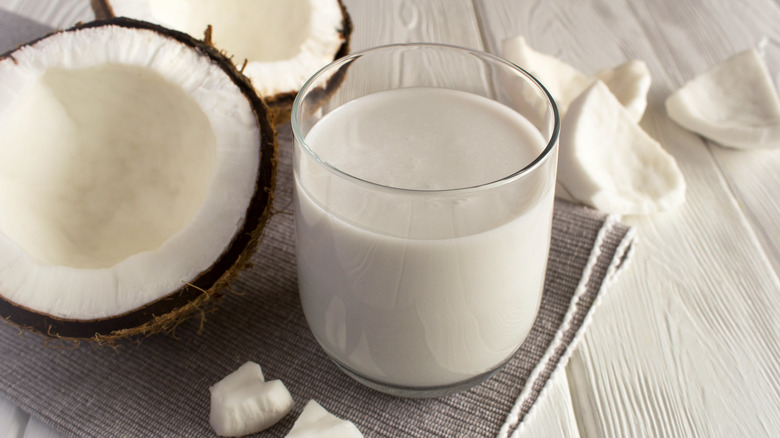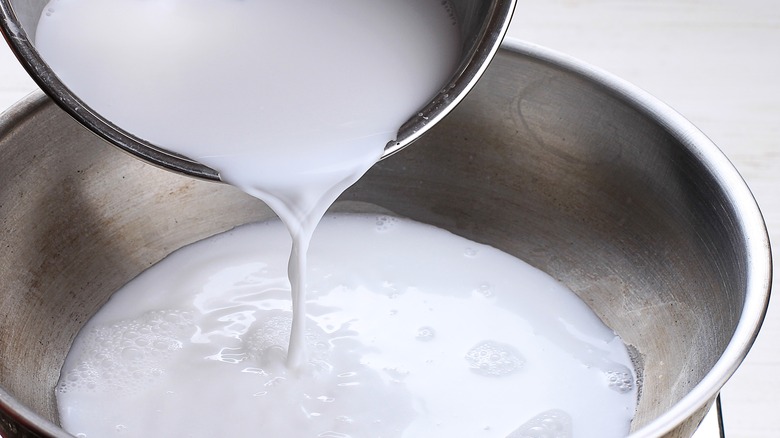11 Tips You Need When Baking With Coconut Milk
If you're new to baking with coconut milk, you're in for a real treat. Coconut milk can enhance the flavor and texture of your baked goods, whether you're making chocolate chip cookies, vanilla cake, or quick breads like banana bread. It's also naturally dairy-free, making it an excellent alternative to regular cow's milk. However, it's not as simple as cracking open a can of coconut milk and dumping it in your favorite recipe. Given the complex nature of baking and the unique consistency of coconut milk, it's worth learning the best tips for baking with coconut milk.
In case you're wondering, coconut milk is made from the meat of mature coconuts, which grow on coconut trees. The coconut meat is grated, mixed with hot water, then pressed or strained. The result is coconut cream, a thick white cream that can be processed again to make coconut milk. It's also worth noting coconut milk is not the same as coconut water, which is the liquid found in young coconuts. To extract coconut water, all you need to do is crack open a young coconut and pour out the liquid (or drink it with a straw). But if the coconut is left on the tree to grow and mature, the water turns into the fleshy white meat that's used to make coconut milk.
For the best tips on baking with coconut milk, we consulted professional chefs for expert insight. Stephen Chavez is a senior chef-instructor at the Institute of Culinary Education in Los Angeles. McKenzie Dokter is a chef instructor of culinary arts at Auguste Escoffier School of Culinary Arts. Read on to learn about their expert tips, tricks, and suggestions for using coconut milk in baking, from choosing the right fat content to using it in place of dairy products.
Know the difference between canned and boxed coconut milk
There's nothing worse than baking a recipe, only to realize that you've used the wrong type of ingredient. To avoid this blunder when baking with coconut milk, know that there are two types: canned and boxed. Both versions are made from coconut meat, but they differ in terms of fat and liquid content. This results in different flavors, textures, and overall functions in baked goods, so it's worth considering the differences before using the ingredient in a recipe.
According to Stephen Chavez, canned coconut milk is naturally high in fat. This makes it very thick, especially when compared to boxed coconut milk or regular cow's milk. The canned packaging also makes it shelf stable for several years, adds Chavez. You can typically find canned coconut milk in the baking aisle or Asian section of the supermarket. In contrast, coconut milk in the box (or carton) contains less fat and more liquid than its canned counterpart. It's "often watered down and can contain additives like gums or stabilizers for texture, flavor enhancers like sugar taste, and preservatives for longer shelf life," says Chavez. Boxed coconut milk is available in shelf-stable and refrigerated varieties.
Though both canned and boxed coconut milk can be used in baking, they aren't interchangeable due to their textural differences. Case in point: If a recipe relies on the thickness of canned coconut milk, using the boxed kind can weaken the structure of the baked good due to its thin texture. Likewise, a recipe that calls for boxed coconut milk can become too thick and clumpy if you use the canned stuff. With that in mind, always check your recipe and use the right type of coconut milk.
Check the fat content of canned coconut milk
Not only does canned coconut milk have more fat than the boxed version, but it can also contain varying levels of fat. Again, this fat content will determine its texture, and therefore, how it works in your recipe. In general, there are two varieties to choose from: full-fat and light coconut milk. Full-fat coconut milk contains all the fat naturally found in the product, making it delightfully thick and rich. In fact, when you chill a can of full-fat coconut milk, the fat will separate from the liquid, creating a layer of white cream that can be scooped.
Light coconut milk, also known as reduced-fat coconut milk, is technically the same product as the full-fat kind. The main difference is that it's been diluted with water, which decreases the fat content per can. Some manufacturers might also add stabilizers and additives to light coconut milk to improve its overall texture.
Although full-fat coconut milk is typically used for baking, if you want to use the light version, don't bother buying it in stores. You can simply blend full-fat coconut milk with water in a blender to dilute it. This way, you'll end up with more than a can's worth of light coconut milk, therefore saving you money. Not to mention, you'll be able to water down the milk to your preferred consistency.
Get familiar with other forms of coconut milk
As it turns out, the wonderful world of coconut milk doesn't stop at the canned and boxed varieties. There's also coconut cream, cream of coconut, and coconut condensed milk, all of which are different types of coconut milk. Each version also contains varying levels of fat and sweeteners, and ultimately, different purposes and best uses in baking.
Coconut cream is simply the thick white portion in full-fat canned coconut milk. You can buy it on its own in cans or scoop it out of full-fat coconut milk. The trick is to chill the canned coconut milk, which will allow the fat and oily liquid to separate. When you open the can, you'll be able to scoop out the coconut cream with a spoon. In baked goods, coconut cream is excellent for creating a creamy texture, says Stephen Chavez. "It's great used in cheesecake (or other custards), can be used to make plant-based ice cream, and it can be whipped and used in place of whipped cream," shares Chavez.
Despite the similar names, cream of coconut and coconut cream are different ingredients. Cream of coconut — which is also known as crema de coco — is made by blending and lightly heating coconut cream, water, and sweetener. The result is a thick, off-white liquid that's often used in tropical cocktails (think piña colada) and coconut cream pie. And then there's coconut condensed milk, which is made of coconut milk and sweetener, such as sugar. The ingredients are simmered until the milk is reduced by half, which is longer than the time needed to make cream of coconut. This creates a more concentrated syrup-like liquid that can be used like regular condensed milk in desserts.
Pay attention to the sweetness and flavor
On its own, coconut milk is naturally low in sugar. However, some products might contain added sweetener, so it's a good idea to look for unsweetened coconut milk when using it in baking. Otherwise, "sweetened coconut milk can throw off the flavor balance and sweetness of your dish," explains McKenzie Dokter. This can result in an overly sugary baked good, potentially making it unpleasant to eat. If you only have sweetened coconut milk on hand, "it's a good idea to reduce any added sugars in the recipe to keep everything in check and prevent it from being too sweet," recommends Dokter.
The same goes for flavored coconut milk, which is typically found in boxed form. Most often, flavored coconut milk is sweetened and enhanced with vanilla flavoring. It's a tasty add-in for coffee and smoothies, but it might not always work in baked goods, as it can be difficult to control the amount of sweetener and flavoring. If you must use flavored coconut milk for baking, consider reducing the sweeteners and vanilla extract in the recipe. This way, you can ensure the sugar and vanilla extract don't overpower the treat.
Use it to make tender baked goods
If you want to elevate your baked goods, add coconut milk to your list of baking pantry staples. "Coconut milk brings richness and moisture thanks to its higher fat content, giving baked goods a tender texture," explains McKenzie Dokter. Here's why: Fats have a weakening effect on gluten (including, protein) in flour. Since gluten contributes to the toughness of a baked product, weakening it results in a more tender texture. Fat can also help retain moisture in baked goods, as they don't evaporate like water during the heating process.
It's worth mentioning that dairy milk, especially whole milk, has a similar effect in baked goods. However, coconut milk is one of the few plant-based milks that can get the job done without sacrificing overall quality. For example, "it often creates a more decadent mouthfeel compared to lighter options like oat or almond milk," says Dokter. Coconut milk is also more ideal than soy milk, which can make baked goods dense, adds Dokter.
Replace dairy with coconut milk
If you'd like to use coconut milk in baking, you'll be glad to know that it's easy to use in place of dairy milk. Simply use a 1:1 ratio when using coconut milk as a substitute. In other words, if your original recipe calls for 1 cup of whole milk, you can use the same amount of coconut milk (1 cup). "The best substitute would be canned light coconut milk (4% to 7% fat) or carton coconut milk (4%)," says Stephen Chavez. Plus, in most cases, you won't have to adjust the baking temperature or time when making this substitution.
Coconut milk can also be used in place of heavy cream, another popular baking ingredient. The best option is full-fat coconut cream, which you can buy on its own or scoop out from canned full-fat coconut milk. Just be sure to avoid using the oily liquid that separates from the cream, says Chavez. "This will give you an even higher percentage of fat," he notes.
Combine coconut milk with dairy
When it comes to baking with coconut milk, it doesn't have to be all or nothing. If a recipe calls for dairy milk, coconut milk can replace part of the listed amount, as it's an ideal dairy substitute. This approach is helpful if you want to enhance the tenderness of the baked good, since coconut milk is so high in fat. It's also ideal for adding a light coconut flavor to a recipe without overdoing it. This method is often used in coconut cream pie, which features a custard made of coconut milk and whole milk. Since the dessert also contains other coconut ingredients, like cream of coconut and coconut-flavored rum, combining coconut and dairy ensures the custard isn't too coconut-forward.
Similarly, if your original recipe uses coconut milk but you'd like to reduce the coconut flavor, you can replace some of it with dairy milk. Just keep in mind that this technique will add dairy to the baked goods, so use caution if you're serving the treat to someone with lactose intolerance or dairy allergies.
Beyond flavor and texture, combining coconut milk and dairy has practical benefits. If you don't have enough of either ingredient, you can easily replace the remaining amount with the other milk. For example, if you need 1 cup of milk but only have ½ cup on hand, mix it with ½ cup of coconut milk and you're good to go.
Learn when to mix canned coconut milk
As mentioned, full-fat coconut milk is made of two parts: a semi-translucent, oily liquid and a solid white cream known as coconut cream. When chilled, the liquid and cream separate, letting you use each portion on its own. You can easily combine these parts by shaking the can and mixing with a spoon, but you might want to think twice before doing so. For some recipes (like our dairy-free birthday cake or vegan frosting), you'll only need the thick coconut cream, so you'll want to leave it unmixed.
Alternatively, if you're using coconut milk in place of whole milk in a recipe, you'll need a more uniform mixture. In this case, shake the can to emulsify the oily liquid and cream. If they don't fully combine, try combining them in a food processor or blender. The trick is to avoid puréeing the mixture for too long, which can make the mixture frothy and bubbly.
Wait to mix coconut milk with an acid
If your recipe uses both coconut milk and acid ingredients, take note of when you combine them. Sure, mixing them early might speed up the baking process, but it can actually ruin your recipe. "Mixing coconut milk with acids like lemon juice or vinegar too early can lead to curdling or separation," explains McKenzie Dokter. "The best approach is to combine them just before the end of cooking or right before mixing it into your dry ingredients. This way, you can keep the coconut milk creamy while still benefiting from the acidity's flavor boost."
A quick science lesson: Curdling happens because acids lower the pH of coconut milk. This changes the structure of proteins in the milk, leading to clumping and curdling. This is more prominent in dairy milk, but it can certainly happen in coconut milk. In fact, some bakers rely on this curdling effect when making vegan buttermilk. The process involves adding acid to unsweetened coconut milk, then waiting 10 minutes for the mixture to curdle. This is desirable if you actually need dairy-free buttermilk — but if not, be sure to avoid letting coconut milk sit with acid for too long.
Use coconut milk to add nuttiness
Aside from its rich and creamy texture, coconut milk is known for its versatile flavor. It's deliciously complex, boasting a floral nuttiness and mild sweetness, if any at all. Additionally, since coconut milk is not naturally sugary, it can be easily sweetened to reach your desired level of sweetness. Its creamy texture also has a cooling quality, making it ideal for balancing more intense flavors in recipes.
All that being said, if you want to enhance the nuttiness and tropical quality of your baked goods, reach for coconut milk. "Coconut milk pairs beautifully with tropical flavors like pineapple, mango, and banana," says McKenzie Dokter. "Plus, it shines in desserts like puddings, ice creams, and cakes, where its creaminess complements flavors like chocolate, vanilla, and sweet spices."
Remember, coconut milk gets its iconic taste from fat, so using full-fat coconut milk is key if maximum flavor is your goal. Depending on your recipe, reduced-fat coconut milk may still add some flavor, but it won't be as prominent.
Heat it gently
If your baking recipe involves heating coconut milk (or a mixture that contains coconut milk), do it slowly. Heating coconut milk too quickly can cause curdling, just like acidic ingredients. In fact, the chemical reaction that takes place is similar; heat changes the structure of proteins in coconut milk, resulting in clumping and curdling. This is more likely to happen if you heat coconut milk to temperatures higher than 176 degrees Fahrenheit.
Luckily, in addition to heating coconut milk slowly and gently, it's possible to further reduce the risk of curdling. Combine 1 tablespoon cornstarch with a bit of coconut milk, then mix it to create a paste. Add the paste to the coconut milk and continue heating it as needed. The cornstarch will help stabilize the coconut milk, though you'll need to heat the coconut milk for at least 10 minutes to reduce the flavor of cornstarch. If you don't have cornstarch on hand, you can also use tapioca starch.
